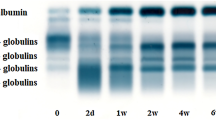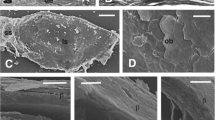Abstract
MOST animal tissues and body fluids contain two types of cholinesterase which have been designated as true cholinesterase and pseudocholinesterase in accordance with their physiological function1. Both enzymes are inhibited to about the same extent by low concentrations of eserine as well as of prostigmine. In order to measure the activities of the two enzymes separately in a mixture of both, Mendel et al. 2 used what they considered to be ‘specific substrates’: acetyl-β-methylcholine for the true cholinesterase and benzoylcholine for the pseudocholinesterase. Since the sera and tissues of ruminants do not exhibit appreciable eserine-sensitive activity towards benzoylcholine, it had been assumed that they do not possess any pseudocholinesterase3. However, it has recently been found that the spleen of the ox4 and other tissues of ruminants5 contain enzymes capable of hydrolysing butyrylcholine, an ester which is hydrolysed rapidly by the pseudocholinesterases of other species but not by the true cholinesterases6.
This is a preview of subscription content, access via your institution
Access options
Subscribe to this journal
Receive 51 print issues and online access
$199.00 per year
only $3.90 per issue
Buy this article
- Purchase on Springer Link
- Instant access to full article PDF
Prices may be subject to local taxes which are calculated during checkout
Similar content being viewed by others
References
Mendel, B., and Rudney, H., Biochem. J., 37, 59 (1943).
Mendel, B., Mundell, D. B., and Rudney, H., Biochem. J., 37, 473 (1943).
Mendel, B., and Rudney, H., Science, 100, 499 (1944). Gunter, J. M., Nature, 157, 369 (1946). Mendel, B., and Myers, D. K., Nature, 170, 928 (1952).
Bannister, J., Whittaker, V. P., and Wijesundra, S., J. Physiol., 121, 55 (1953).
Davies, D. R., Risley, J. E., and Rutland, J. P., Biochem. J., 53, xv (1953).
Cohen, J. A., Kalsbeek, F., and Warringa, M. G. P. J., Acta Brev. Neerland. Physiol., 17, 32 (1949).
Koelle, G. B., Biochem. J., 53, 217 (1953).
Myers, D. K., Biochem. J., 55, 67 (1953).
Hawkins, R. D., and Mendel, B., Brit. J. Pharmacol., 2, 173 (1949).
Aldridge, W. N., Biochem. J., 53, 62 (1953).
Hawkins, R. D., and Gunter, J. M., Biochem. J., 40, 192 (1946).
Austin, L., and Berry, W. K., Biochem. J., 54, 695 (1953).
Earl, C. J., and Thompson, R. H. S., Brit. J. Pharmacol., 7, 261 (1952).
Author information
Authors and Affiliations
Rights and permissions
About this article
Cite this article
MENDEL, B., MYERS, D. Identification of Pseudocholinesterase in the Tissues of Ruminants. Nature 176, 783–784 (1955). https://doi.org/10.1038/176783b0
Issue Date:
DOI: https://doi.org/10.1038/176783b0
This article is cited by
Comments
By submitting a comment you agree to abide by our Terms and Community Guidelines. If you find something abusive or that does not comply with our terms or guidelines please flag it as inappropriate.



